Air plants have become increasingly popular lately, and it is easy to see why. These amazing plants have a unique appearance and can grow without soil! In addition, you can display air plants in a variety of ways, and they require relatively little maintenance.
Although air plants are often touted as a low-maintenance alternative to “traditional houseplants,” many people find it difficult to keep them alive. I believe this is, in part, because there is so much conflicting information about air plant care. In reality, different kinds of air plants require different amounts of light, water, and fertilizer. This makes sense after you consider that air plants are found in different parts of the world and have adapted to different environmental conditions.
I have owned many air plants over the years. Admittedly, I killed many air plants before I figured out what works. This article is a compilation of what I have learned from owning many air plants and doing a ton of research.
About Air Plants
In order to properly take care of your air plants, it is important to have a basic understanding of how they grow. This understanding will help you understand how to meet their needs and will provide you with the knowledge necessary to ask questions and conduct your own research about air plants.
Air plants belong to the Tillandsia genus which is comprised of over 500 species of flowering plants. The Tillandsia genus belongs to the Bromeliad family which is comprised of almost 4,000 species of monocot flowering plants such as the pineapple.
Tillandsias are unique plants because they are epiphytes. That means that they attach themselves to other plants for support. Some species of tillandsia also grow as lithophytes meaning that they attach themselves to rocks. Although Tillandsias may depend on another plant for support, they are not parasitic. This means that they do not harm or take nutrients away from their host plant.
Blooming
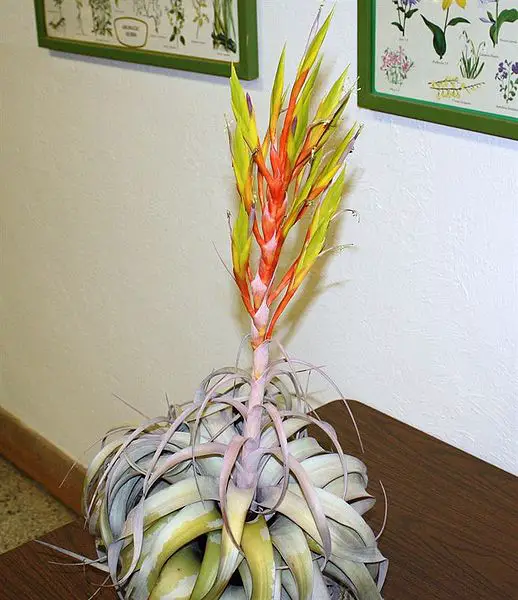
Source: WikiMedia Commons, Bocabrom
Air plants bloom once during their lifetime. It takes Tillandsia seeds several months to germinate. After germination, it takes several years for an air plant to fully mature and bloom. Some blooms will last for several months, but some blooms will last for only a short period of time. For example, blooms from Tillandsia strictas will only last for one day.
Prior to blooming, air plants may begin to “blush.” Placing your air plants in an area that is exposed to bright morning sun will make the plant turn an even more vibrant pink color.
Keep in mind that some Tillandsia sellers will paint air plants in order to give them a blush appearance. Enhanced air plants will be discussed in further detail in a separate section.
Some growers will force Tillandsias to bloom using ethylene gas, Florel, Omaflora, and Ethrel. Some of these store-bought chemicals can disrupt pup formation. Using these chemicals incorrectly can also be harmful to human health. Luckily, there is an easier way for home growers to force their air plants to bloom. Simply place your Tillandsia in an airtight plastic bag for 2 to 3 days with sliced apple. The apple will produce ethylene, which is the only naturally occurring gaseous plant growth hormone. According to the Rutgers Cooperative Extension of Atlantic County, flowering should begin within 6 to 14 weeks.
When your air plant does bloom, continue to water your plant and make sure it is exposed to sunlight. Just make sure that you do NOT get the flower wet during watering. Water can cause the flower to rot and can significantly shorten the bloom time.
After blooming, air plants will begin to produce offshoots or “pups.”
Tillandsia Pups

Source: Reddit r/airplants, Taken by S.K.
Most air plants will produce 1-3 offsets, which are also known as pups after the flower has died. Some types of Tillandsias will produce more pups. For example, Tillandsia xerographica typically produces 6 to 8 pups. Pups are clones of the mother plant.
Some species of Tillandsia will produce pups at the base of the plant while others will produce pups that grow from the center of the plant.
In the wild, the pups will stay attached to the mother plant until the mother plant dies. This results in a clump of air plants. If you do not want to grow a clump of air plants, you can simply detach the pups from the mother plant when the pup is 1/3 to 1/2 of the size of the mother plant. If you remove pups when they are too small, you decrease their chance of survival because they are no longer receiving nutrients from the mother plant.
To remove pups from the mother plant, hold the mother plant and gently twist the pup until it detaches from the mother plant. Alternatively, you can cut the pup off. Make sure you cut as close as possible to the mother plant. The following video demonstrates how to remove pups from air plants.
To encourage your air plant to produce pups, make sure that you are providing it with the proper amount of light, water, and fertilizer.
Trichomes on Air Plants
Another important characteristic of air plants is trichomes. Trichomes are the small hairs you see on some air plants. The word trichome is derived from the Greek word trichōma which means hair. Trichomes can also be found on algae and protists.
Air plants’ epidermal trichomes allow them to absorb water, minerals, and organic nutrients that the plant needs. These trichomes have a nail-like shape, formed by an axis (stem) connected to the internal tissues of the leaf, and by an external shield (Papini et al. 2020). The shield cells die during the last stage of trichome development which enables them to absorb water and nutrients (Papinin et al. 2020).
A study conducted by the Tokyo University of Agriculture examined the ability of Tillandsia ionantha to absorb water. As part of this study, the researchers observed radiolabeled water being taken up by the leaves via capillary action of the epidermal trichomes within 1 minute. The leaves absorbed 30-40% of the plant weight in water (Ohrui et al. 2007).
Tillandsia tectorum is the best example of trichomes on an air plant. They look like fuzzy snowballs due to the abundant number of trichomes. Because of the numerous trichomes, Tillandsia tectorum prefers frequent mistings to soaks.
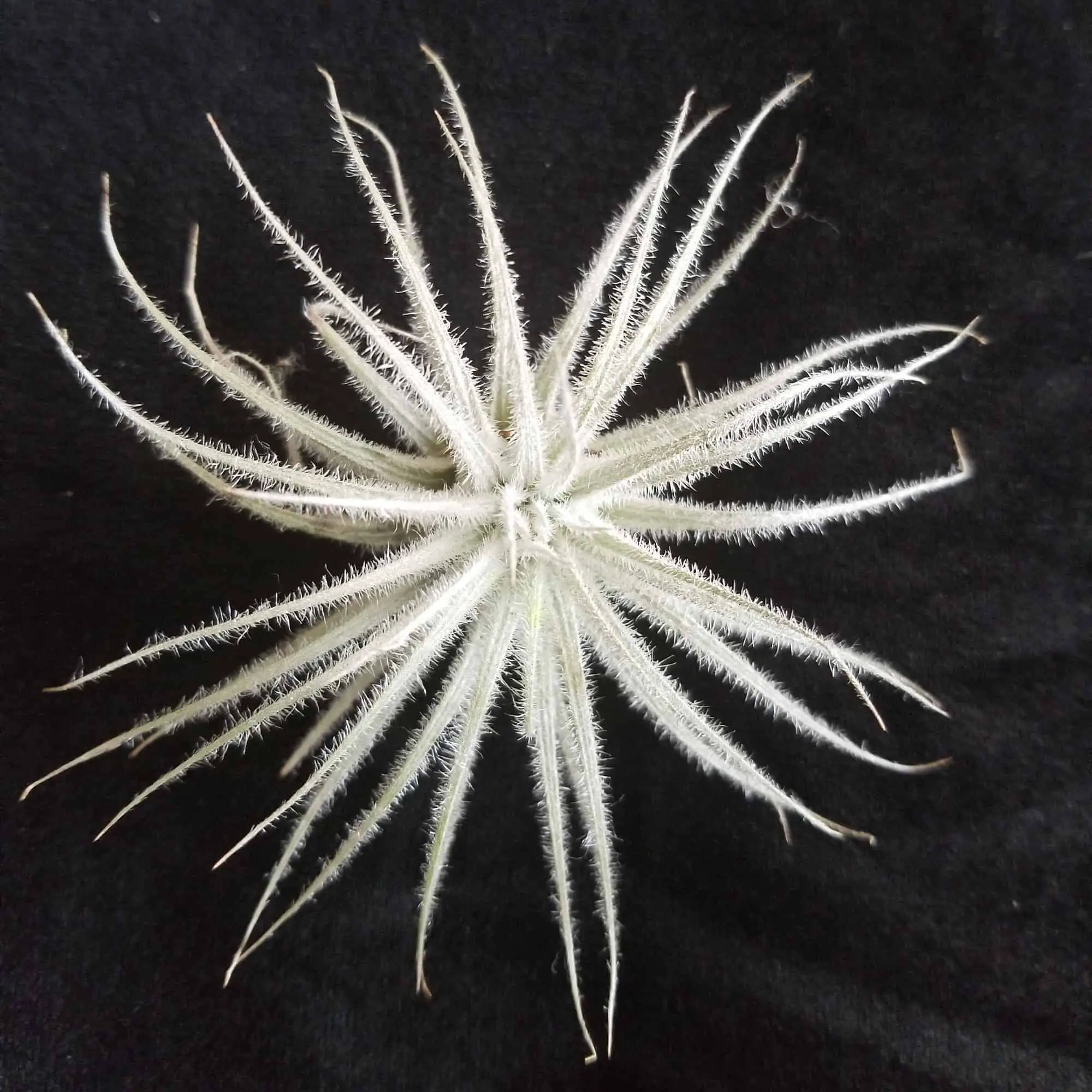
Xeric, Mesic, And Hydric Air Plants
As one might expect, different types of air plants will require different care (e.g., watering, fertilizer, light). There is definitely not a “one size fits all” approach to taking care of air plants. Understanding whether your air plant is Xeric, Hydric, or somewhere in between (Mesic) will significantly increase your chances of keeping your plant alive for more than a couple of months.
Xeric Air Plants
Xeric is derived from the Greek word xeros which means dry. The word “Xeric” was coined in 1926 and was commonly used in the scientific world by the 1940s.
Xeric air plants grow in drier climates than Mesic air plants and Hydric air plants. Some of these air plants even grow in deserts and live as epiphytes on cacti. However, most Xeric air plants live in dry tropical forests or in exposed spots in more humid tropical forests.
Although Xeric air plants will grow roots, they do not function in the same way as most plants’ roots. Xeric air plants’ roots do not absorb water or nutrients. They simply anchor the plant to its host plant or support. Some Xeric air plant species, such as Spanish Moss, don’t even have roots.
In the wild, Xeric air plants tend to grow at higher altitudes and are exposed to more sunlight. In general, Xeric air plants require less water and can tolerate more intense sunlight than Mesic or Hydric air plants. In addition, Xeric air plants tend to have more obvious trichomes which gives them a silvery or white color rather than a dark green color.
Some examples of Xeric air plants include:
- Tillandsia xerographica;
- Tillandsia usneoides;
- Tillandsia tectorum; and,
- Tillandsia caput-medusae.
Mesic Air Plants
Mesic is derived from the Greek word mesos which means middle. Mesic air plants can be thought of as preferring wetter conditions than Xeric air plants and drier conditions than Hydric air plants.
Many species of Tillandsia are characterized as Mesic. Unlike Xeric air plants, Mesic air plants are green rather than silver. This is because their trichomes are not as apparent as Xeric air plants’ trichomes. The leaves of Mesic air plants tend to be thin and pliable. The leaves also tend to be tightly curled or cupped at the base. Air plants that fall into this category are native to the rainforest or other humid, densely covered forests. Unlike Xeric air plants, Mesic air plants have the ability to form “normal” roots that can absorb water.
Mesic air plants prefer humid conditions and more frequent watering. In addition, Mesic air plants prefer bright, indirect light. They will burn if exposed to intense sunlight.
Some examples of Mesic air plants are as follows:
- Tillandsia brachycaulos;
- Tilllandsia bulbosa;
- Tillandsia andreana;
- Tillandisa butzii; and,
- Tillandsia cyanea.
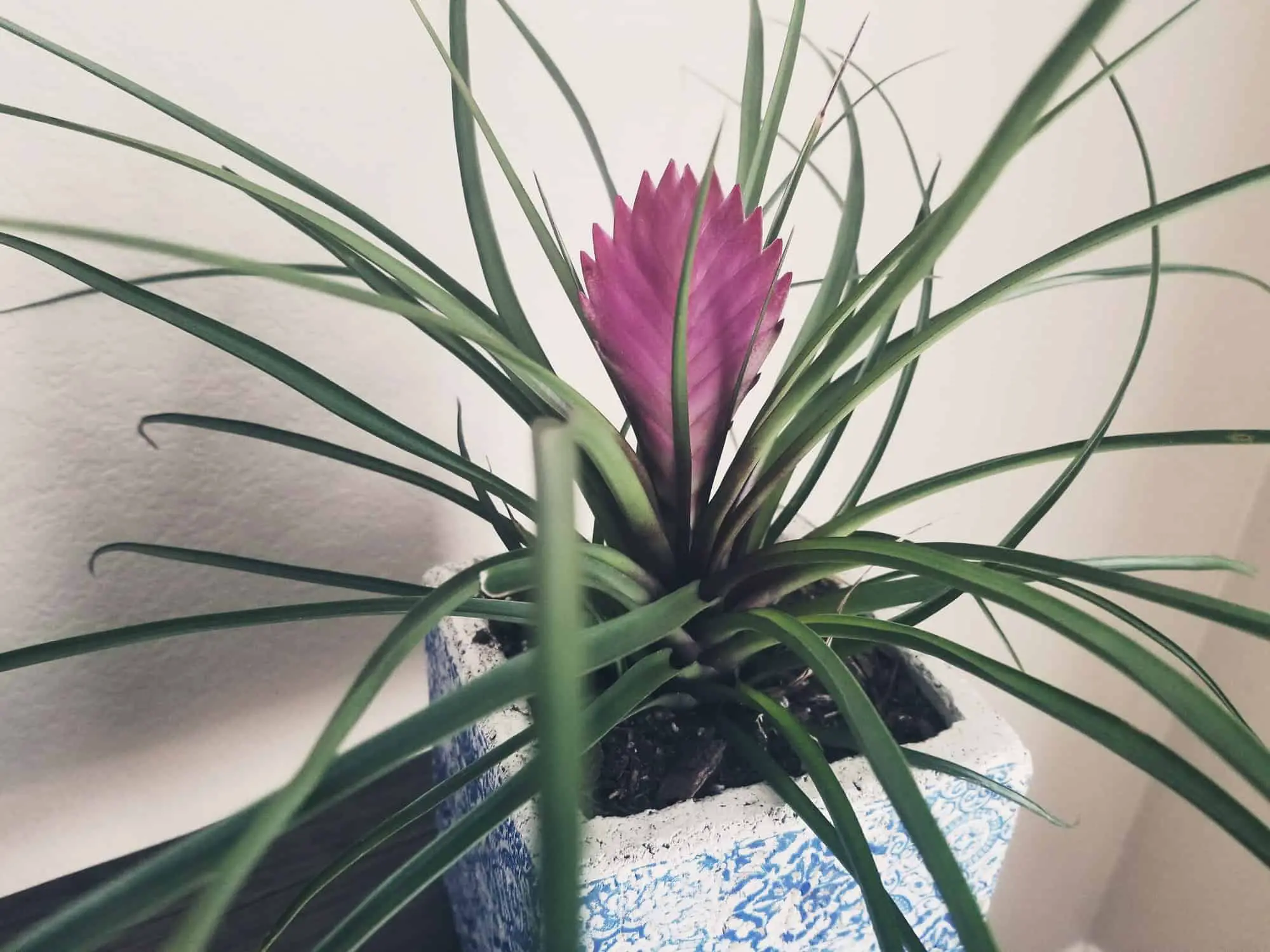
Hydric Air Plants
Hydric air plants grow in water or very near water. These types of air plants are native to places with very wet climates like the Amazon River Delta or the Big Island of Hawaii. Not very many (if any at all) of the air plants sold in stores can be characterized as Hydric because Hydric Tillandsias do not make good houseplants.
Where Can I Buy Air Plants?
There are several places where you can purchase air plants. Grocery stores and almost all gardening centers carry air plants. If you live in the Los Angeles area, I highly recommend checking out Rainforest Flora which is a gardening center that specializes in Tillandsias.
You can also purchase air plants online. Many people are hesitant to buy plants online for obvious reasons, but air plants do seem to ship pretty well. My favorite place to buy air plants online is the Plants for Pets shop on Amazon. Click here to view their shop on Amazon.
There are also numerous air plant shops on Etsy. Etsy is a good place to find air plants that are not widely available.
Make sure you are buying air plants from a shop that obtains their Tillandsias ethically.
Why It Is Important To Purchase Air Plants Responsibly
During the 1980s, some types of air plants, such as Tillandsia xerographica, became so popular that they nearly went extinct. Because air plants take between 3 and 5 years to propagate from seed, nurseries in Guatemala and Honduras could not keep up with the demand for air plants.
During that time, the air plant trade was not heavily regulated, so people were able to trade xerographica (and other tillandsias) taken directly from the wild. Thankfully, the Convention on International Trade in Endangered Species of Wild Fauna and Flora (CITES) put the Tillandsia xerogrpahica on the endangered species. This resulted in stricter regulations on the air plant trade.
CITES currently regulates the trade of three species of air plant: Tillandsia xerographica, Tillandsia harrisii, and Tillandsia kammii. CITES does not consider these air plants to be in danger of extinction, but trade is regulated due to overutilization. To learn more about CITES, click here to check out their website.
To ensure that there will continue to be a plentiful supply of tillandsias, make sure that you only purchase air plants from a source with the required CITES permits. In addition, avoid the temptation to collect air plants from the wild.
Best Air Plants For Beginners
Although air plants are commonly thought of as being low maintenance and easy to care for, proper care does take some practice especially because it does depend on the temperature and humidity of your home. For this reason, I suggest purchasing a low-cost air plant from this list as your first plant. After getting some experience with air plants, you can move on to the rarer and more expensive varieties with confidence.
Tillandsia ionantha
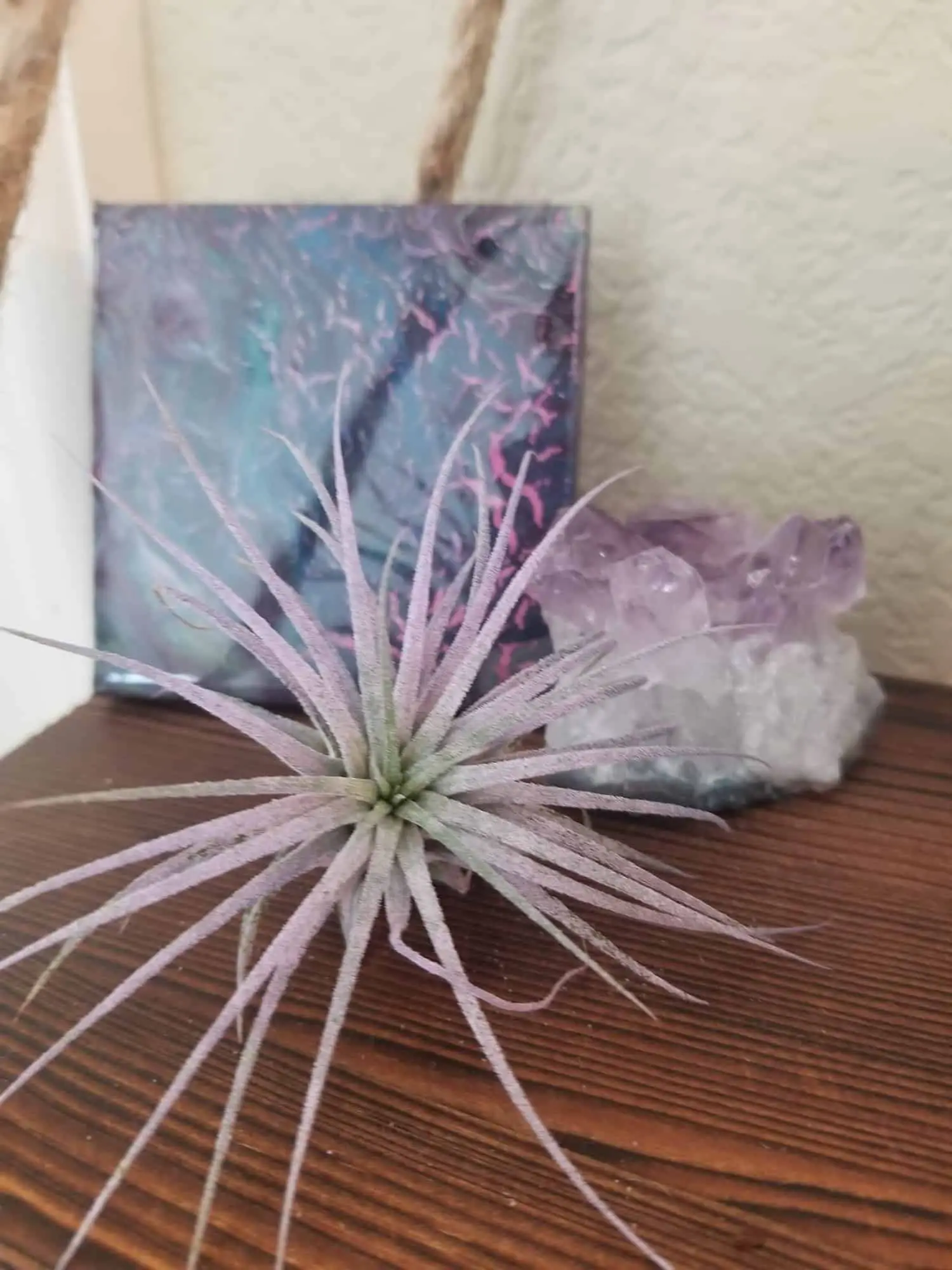
Tillandsia ionantha is probably the most popular and widely available air plant. It is sometimes called the Blushing Bride or Sky Plant. On average, the ionanthas sold at more gardening centers and grocery stores will be between 1 and 3 inches. According to a study conducted by the Tokyo University of Agriculture, these amazing little plants are capable of surviving drought stress for 6 months (Ohrui et al. 2007).
The Tillandsia ionantha is native to the tropical forests of Mexico, Costa Rica, Nicaragua, El Salvador, Guatemala, and Honduras. You can also find them growing in the wild in certain parts of Florida.
One of the most exciting parts of owning an ionantha plant is seeing it bloom. These plants produce little purple flowers. You will know when an ionantha is about to bloom because it will start to “blush” or turn red.
Tillandsia xerographica

Tillandsia xerographica is another popular type of air plant. It is extremely popular and can be found in almost every store that sells air plants.
Tillandsia xerographica air plant is often called the King of the Air Plants due to its large size. It is native to the Central American countries of Mexico, Guatemala, and Salvador. In the wild, xerographica plants can be found growing the highest branches.
Tillandsia xerographica takes a long time to grow. The smaller xerographica plants that you see in stores are typically between 4 and 5 years old. In the wild, it takes xerographica plants between 12 and 18 years to bloom. However, cultivated varieties are often smaller and will bloom within 6 to 8 years with the help of fertilizers. Xerographica plants will begin to grow pups 5 to 12 months after blooming, and most xerographica plants produce 1 to 3 pups.
Tillandsia harrisii

Tillandsia harrisii is a type of air plant with fuzzy, silver leaves. It is a good choice for first-time air plant owners because it is very forgiving of mistakes.
Tillandsia harrisii is native to Guatemala. In the wild, they are found at altitudes between 0 to 500 meters above sea level. This species of air plant was named for Bill Harris who was a Canadian business consultant who started the first tillandsia exporting business in Guatemala during the 1970s. Tragically, Bill Harris was murdered in February of 1986.
The harrisii plant will eventually bloom beautiful pink and purple flowers. The bloom will typically last between two and three weeks.
Tillandsia harrisii does best in bright indirect light. However, it can withstand some full sun. They also do best in environments with low to moderate humidity.
Tillandsia stricta

The leaves of the Tillandsia stricta can be soft or stiff depending on the plant. This is because stricta plants have adapted to survive in a variety of environmental conditions.
Tillandsia stricta is native to Trinidad, Brazil, Venezuela, Paraguay, Uruguay, Guyana, and northern Argentina. In the wild, they can be typically found growing on sand dunes or in trees.
This air plant typically matures during the summer months and will produce a white spike that will eventually bloom blue or purple flowers. Unlike other types of air plants, these flowers will only be around for one day! After a stricta plant blooms, it will produce 1 to 3 pups.
Tillandsia butzii
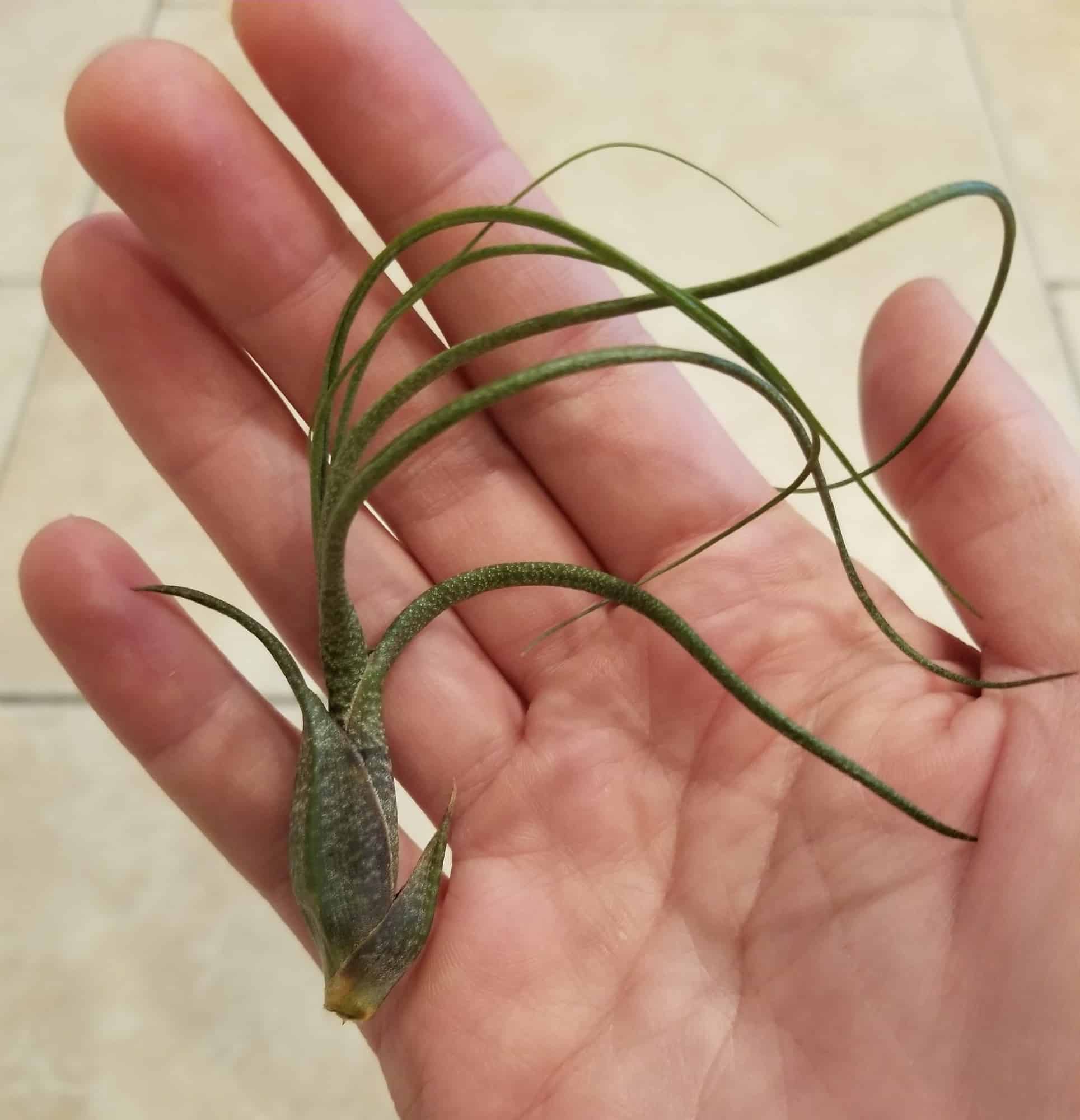
Tillandsia butzii is a unique species of air plant that has wiry leaves and a bulbous base. Unlike many other species of air plants, the leaves do not have a fuzzy texture. The leaves of a butzii plant are actually smooth and will form beautiful curls. You can display these air plants by hanging them upside down or by mounting them on driftwood.
Tillandsia butzii is native to southern Mexico, Costa Rica, and Panama. They are typically found at altitudes ranging from 1,250 to 2,200 meters. In the wild, the bulbous base acts as space for ants to colonize. The butzii plant will absorb nutrients from the detritus of the ants.
I water my butzii plants by putting just the leaves in a bowl of water. I do not soak the entire plant because water can easily get trapped in the compact leaves at the base which can cause rot. If you do soak the whole plant in water, gently shake the butzii plant after you remove it from the water. Then make sure you hang your butzii plant upside down while it dries.
Watering Air Plants
One of the most common misconceptions about air plants is that they can absorb all of the water they need from the air. While this may be true for some air plants in the wild, the typical indoor climate does not perfectly mirror air plants’ natural habitat.
Watering air plants is both a science and an art because different strategies seem to work depending on the situation. As a result, there is a lot of conflicting information about watering air plants, but the bottom line is that the goal of watering is to mimic your air plant’s natural habitat. Because different species of air plants are native to different types of habitats (recall the discussion on Xeric air plants vs Mesic air plants), watering depends on the type of Tillandsia.
Watering Mesic Air Plants vs Watering Xeric Air Plants
Xeric air plants tend to prefer misting rather than dunking or soaking. Mist your Xeric air plants once every week. Some species have an abundance trichomes (e.g., Tillandsia tectorum) and only need to be misted every two weeks. If my Xeric air plants start to look a little crusty or if they start to get brown tips, I will soak them in lieu of the weekly misting.
In contrast, Mesic air plants prefer weekly soakings. Make sure that the container you use to soak your Tillandsias does not contain any soap residue or other chemicals that could potentially harm your plants. After soaking my air plants, I like to gently shake off any excess water before laying them out to dry.
Keep in mind that the frequency of watering also depends on the conditions of your home. If your house tends to be more humid or you live in a subtropical climate like Florida, you will not need to water your air plant as frequently as someone who lives in Arizona. If you are unsure about how often you should water your air plant, it is better to err on the side of slightly underwatering.
After watering your plant, it is absolutely essential that you allow your plant to dry completely in such a way that excess water can drain away from the leaves. Leave your air plants in a sunny area for 12 to 24 hours after a soak or misting. Make sure the sunlight is not so intense that it burns the leaves. To prevent water from getting trapped in compact leaves, make sure you let your air plants dry upside down.
The Water You Use On Your Air Plants Matters
Ideally, you should use clean rainwater to water your air plants. However, this may not be possible for everyone. If you do not have a way to collect clean rainwater, water your air plants with filtered water or bottled water. You can use tap water, but it is important to make sure that you take some of the steps necessary to remove some of the chlorine.
Like many plants, Tillandsias are sensitive to the chlorine in tap water. If you are going to use tap water for your air plants, put the water in an open container for a couple of hours. This will allow the chlorine to evaporate from the water.
Do NOT use distilled water on your air plants. Distilled water does not have any nutrients, so it will actually suck the nutrients out of your air plant through the process of osmosis.
Ideally, you want to water your air plants using water with a pH between 5.5 and 6.0. Tap water typically has a pH between 6.5 and 8.0. To lower the pH of your tap water, you can use pH Down. This is a chemical commonly used by hydroponic growers.
Reviving A Sick Air Plant
Many people think that their air plants die of overwatering when the plant actually died from underwatering. This is because some air plant owners tend to soak their plants following a long period of not watering. When the plant falls apart, they think it is due to the watering. In reality, it is likely that the plant was already dead.
So how do you know if your air plant is dead or just thirsty? One easy test is to look at the base of the plant. Pull back the top leaf. If there is green at the base of the leaf, your air plant is still alive. If the whole plant falls apart, it is a goner.

If your air plant looks sick or has been neglected, try soaking it in unchlorinated water for an hour. Remove any dead leaves from the base of the plant. Then gently shake the water off of the leaves and allow the plant to dry completely. Make sure you put your plant in a warm area with plenty of sunlight while it dries.
Light
Like every plant, air plants require light to survive. Tillandsias do best when exposed to 4-6 hours of bright indirect light each day. Avoid putting your air plants in the hot sun. More than a few hours of exposure to hot sunlight can deplete tillandsias of their moisture.
A neat characteristic of air plants is that they have the ability to adapt to different light conditions. A study conducted by researchers in Germany found that Tillandsia ionantha has the ability to adapt to low-light conditions and high-light conditions. The ability to adjust photosynthetic rates based on different amounts of light is useful in the wild because it means that these plants can grow throughout the canopy of a host tree (Martin et al. 1999).
If you cannot find an area in your home that receives enough sunlight, grow lights are a great way to provide enough light for your air plants. Fluorescent grow lights are a good option for air plants. Keep your Tillandsias between 6″ and 3 feet away from the grow lights depending on how much heat the lights throw off.
When using grow lights, it is important to make sure to only keep the lights on for 8-12 hours each day. This is important because Tillandsias have special photosynthetic adaptions that require a period of darkness each day. Like many other plants adapted to dry conditions, air plants use the crassulacean acid metabolism (CAM) pathway to save water. This means that air plants do not keep their stomata open during the day. Instead, they open their stomata at night in order to absorb carbon dioxide.
Fertilizing Air Plants
Air plants do not require much fertilizer. While air plants do not need fertilizer to survive, it does help them grow a little faster and encourages the bloom cycle.
To fertilize your air plants, make sure you use a fertilizer made for Tillandsias and dilute the fertilizer to half strength. Fertilize your air plant no more than once per month. Personally, I recommend fertilizing once every 3-4 months because fertilizing your air plants too often can cause nitrogen burn.
Before purchasing an air plant fertilizer, make sure it does not contain urea. Air plants cannot use the nitrogen in urea.
Ideal Temperature Range For Air Plants
Generally, air plants will grow best in warm conditions (65°F – 85°F). Many species can tolerate temperatures as low as 40°F – 50°F. You can keep your air plants outside if you can live in an area that does not experience frost. Otherwise, it is best to keep your air plants indoors. Just make sure you place your tillandsias away from fireplaces, air conditioning units, or drafty windows.
If you live in a colder climate, you can still take your air plant outside on a porch or balcony during the warmer parts of the year. It is just important to make sure they are not exposed to extremely hot temperatures or extremely bright light.
What You Need To Know About Painted Air Plants
Some of the beautiful orange, red, and purple air plants you see in stores are artificially colored. Some artificially colored air plants look very convincing while others have obvious spray paint marks.
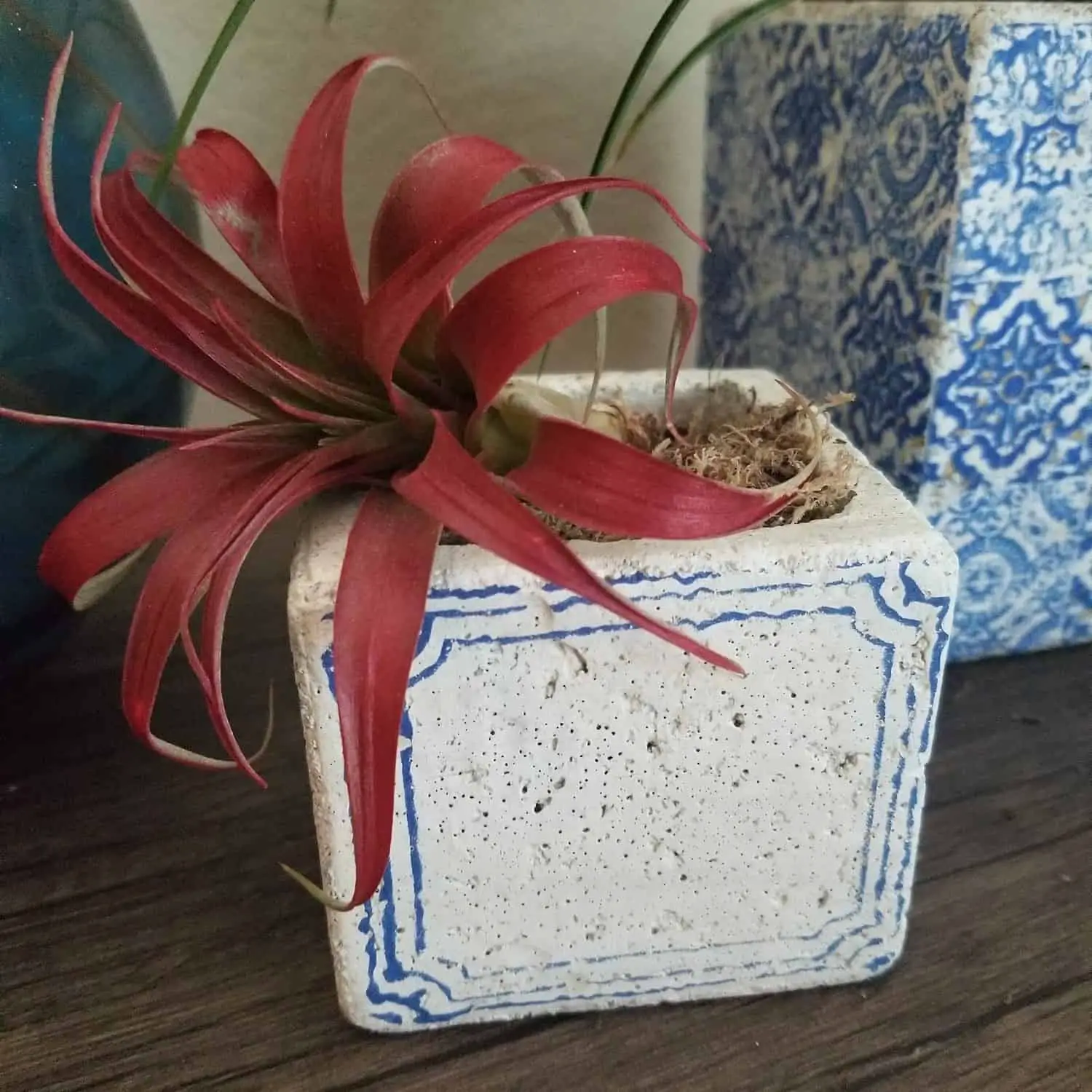
These air plants are referred to as “enhanced” air plants. Enhanced means that the air plant was dyed or painted. Not all painted air plants are labeled as artificially colored or enhanced.
Personally, I don’t mind purchasing a painted air plant as long as it looks nice. It is important to keep in mind that a painted air plant may not live as long as an unpainted air plant. This is because paint reduces the plant’s ability to absorb, water, light, and nutrients from the air.
Sometimes it can be difficult to determine whether an air plant is enhanced. If you are shopping for air plants and want to know whether a particular plant is artificially colored, you can reference the images posted on the following websites. Simply click the link that corresponds to the species listed on the tag.
Are Air Plants Safe For Cats And Dogs?
A lot of house plants can be dangerous for our furry friends. Fortunately, air plants appear to be non-toxic for pets. It is important to note that this statement is based on anecdotal evidence. I was not able to find any scientific studies that examined the effects of air plant consumption on pets. So although air plants are not toxic, they are not particularly edible either. If you have any concerns about keeping air plants around your pets, it is best to consult your pet’s veterinarian.
It is best to keep your plants away from your pets. I have heard many stories of cats and dogs being attracted to the shape of air plants and nibbling on them. Although consuming the plants probably will not hurt your pet, it can take a long time for your plant to recover. Here are some tips for keeping your air plants away from pets:
- Display your air plants in a terrarium that is not accessible to pets.
- Keep your air plants on shelves that are out of reach of pets.
- Hang your air plants from wire or mount them on a “living frame” that is out of the reach of pets.
If your pets do get a hold of your air plants, make sure you trim any broken tips or leaves.
References
Martin, Craig; Tüffers, Arnd; Herppich, Werner; and von Willert, Dieter. Utilization and Dissipation of Absorbed Light Energy in the Epiphytic Crassulacean Acid Metabolism Bromeliad Tillandsia ionantha. International Journal of Plant Sciences 160, no. 2 (March 1999): 307-313.
Ohrui, T.; Nobira, H.; and Sakata, Y. Foliar trichome- and aquaporin-aided water uptake in a drought-resistant epiphyte Tillandsia ionantha Planchon. Planta 227, 47–56 (2007). https://doi.org/10.1007/s00425-007-0593-0.
Papini, Alessio; Tani, Gabriele; Falco, Pietro; Brighigna, Luigi. (2010). The ultrastructure of the development of Tillandsia (Bromeliaceae) trichome. Flora – Morphology, Distribution, Functional Ecology of Plants. 205. 94-100. 10.1016/j.flora.2009.02.001.

